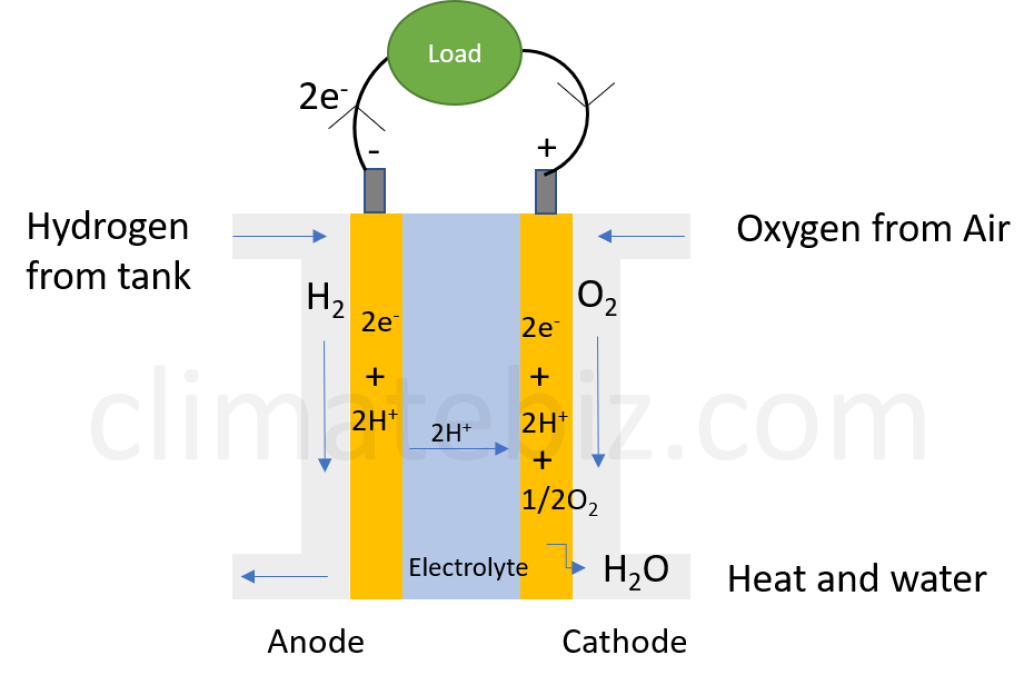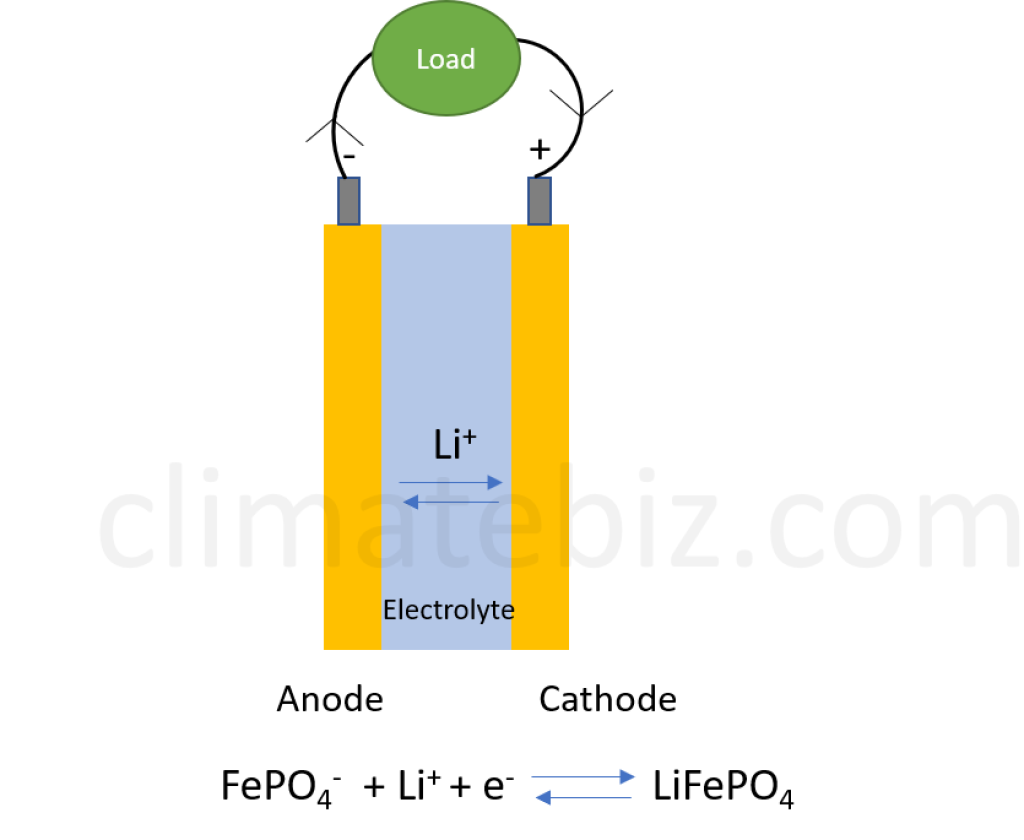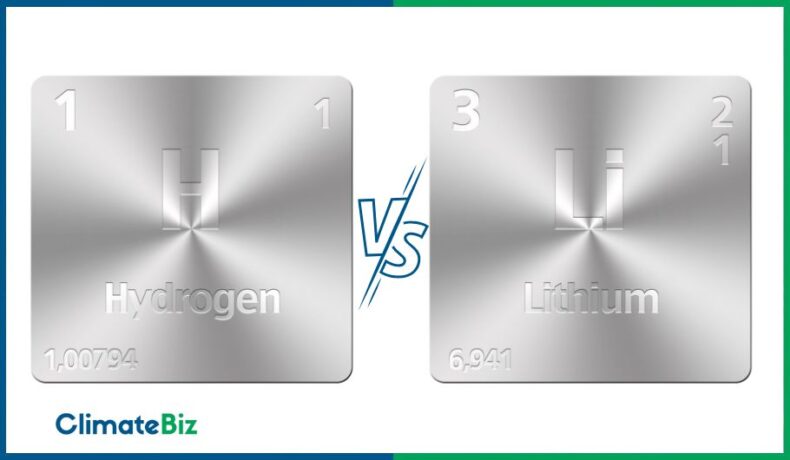Hydrogen fuel cells vs. lithium-ion batteries: two exceptional technologies powering electric vehicles (EVs).
Electric vehicles, EVs, are seen as the future of mobility. In 2022, they account for 6% of all vehicle sales in the US, with a target of 50% by 2030. Some countries go even further. In Europe, the sale of new petrol cars will be banned starting in 2035.
In this technical revolution, oil is replaced by electricity and our gas tank by lithium-ion batteries. However, like all new technologies, lithium-ion is not without its flaws, and a challenger, the hydrogen fuel cell, could also get its share of the pie.
Let’s review both technologies and find out what the future of electric vehicles looks like.
Table of Contents
Hydrogen fuel cells vs. lithium-ion batteries: what’s the difference?
There is a major difference between hydrogen fuel cells and lithium-ion batteries:
A fuel cell generates electricity from hydrogen (H2) and oxygen (O2), whereas lithium-ion battery stores and supplies electricity and requires an external source for charging.
As shown below, the fuel cell is always coupled with a hydrogen tank and a lithium-ion battery in an EV.

Hydrogen fuel cells and lithium batteries both use (electro)chemical reactions to generate or store electricity.
Their active materials and core reactions are different, but they share the same parts:
- Cathode.
- Anode.
- Separator (membrane).
- Electrolyte.
- Current collector.
Let’s quickly review their working principle.
Hydrogen fuel cell: working principle
Hydrogen gas (the fuel) is fed at the anode, and air enters by the cathode. A catalyst, usually platinum, at the anode separates hydrogen into protons (h+) and electrons (e–). The electrons flow into the electrical circuit, and the protons travel from the anode to the cathode to react with oxygen and generate water and heat as a by-product.

Lithium-ion battery: working principle
A lithium-ion battery is a device that converts electricity into chemical energy. An electrochemical reversible reaction can store electricity (charging) or supply electricity (discharging).
In a lithium-ion battery, lithium ions (Li+) are exchanged between the anode and the cathode.
During the charging process, electrons flow from the anode to the cathode inducing a transfer of the lithium ions from the cathode to the anode. The opposite reaction happens during discharge.

Are hydrogen fuel cells more efficient than lithium-ion batteries?
The efficiency of a hydrogen fuel cell is around 50%. In other words, 50% of the hydrogen supplied to the fuel cell is effectively converted into electricity.
The efficiency of a lithium-ion battery is around 98%. Nearly all electrons that go through the battery are effectively stored and released (charge and discharge).
However, keep in my mind that we cannot directly compare the efficiency of a fuel cell and a lithium-ion battery. Indeed, the fuel cell generates electricity from a primary energy source (hydrogen), and the battery stores electricity and needs an external source of electricity to be charged.
Hydrogen fuel cells vs. lithium-ion batteries: Infrastructure
Undoubtedly, electric vehicles will take over our traditional combustion engines in the near future.
For this energy revolution to become a reality, massive infrastructure investments are needed.
The developments are mainly focused on the following:
- Production facilities.
- Distribution system.
- Charging station.
In the chart below, we’ve summarized the infrastructures needed for both technologies:
| Hydrogen fuel cells | Li-ion batteries | |
|---|---|---|
| Production facilities | Hydrogen production plants | Power plants |
| Distribution system | Pipes and tanks | Electrical transmission lines |
| Charging station | Hydrogen refilling station | Charging stations |
Li-ion batteries infrastructure
Although quite recent, Li-ion is the most mature technology.
The main challenge with EVs is to supply electricity quickly to multiple locations.
In 2022, the average EV battery size is 50kWh, with a charging time (10%-80%) of 35 minutes on a rapid charging station vs. 7 minutes on a full gas tank. This is the weak point of electric vehicles: the slowness of charging.
This technical problem is a huge challenge for engineers. On the one hand, they are trying to improve batteries to accept higher charging power. On the other hand, they are facing the technical challenge of supplying high-power charging stations.
Currently, the Tesla supercharger reaches 250kW, and your EV will get 200 miles of extra autonomy in 15 minutes. This is still very far from our petrol cars. To cut the recharge time by 2, we would need a 500kW supercharger.
Now let’s do a simple calculation, if 5 cars are connected to a charging station, the instant power needed is 2.5MW.
There are more than 140,000 EV chargers in the US (53,000 charging stations). If all charging stations are equipped with a future 500kW supercharger, the instant power needed would be roughly 53’000 x 2.5MW= 132GW.
This is equivalent to 132 nuclear reactors!
In conclusion, we need huge investments in new power plants and electricity grids for EVs to be massively adopted.
Hydrogen fuel cell infrastructures
Popularized by Jeremy Rifkin in his book the hydrogen economy (2002). Hydrogen is seen as the most promising candidate to replace our fossil fuel economy.
However, after more than 20 years, the development of infrastructures is still extremely limited.
Switching from petrol to hydrogen requires massive investment in hydrogen production facilities, distribution, and refilling stations.
Hydrogen doesn’t exist as a natural source and needs to be produced. Currently, 98% of hydrogen production is from fossil fuels. The challenge is to switch to renewable sources such as water electrolysis powered by solar or wind energy.
With only 107 refilling stations in the US, the hydrogen distribution system is extremely limited. There is still a long way to go before hydrogen and fuel cells become a reality for our vehicles.
Will hydrogen cars overtake electric vehicles?
Over the long term — 30 to 40 years — there is a chance for hydrogen cars to overtake electric vehicles.
The main reason is that it is much easier to store and transfer hydrogen than electricity.
Semi-commercial hydrogen cars can already achieve fast refilling, gaining 300 miles in 3 to 5 minutes, with a total range of more than 840 miles for the Toyota Mirai.
That said, we’re still far from seeing hydrogen fuel cells becoming mainstream.
Hydrogen vs. lithium-ion: what does the future look like?
There is no doubt that the future of automotive is electric, but will our future electric cars be powered by lithium-ion batteries or fuel cells?
Although fuel cell cars can already achieve fast refilling and hold the same autonomies as petrol cars, it is likely that the technology will not take over the EV market yet.
To become a reality, the hydrogen economy needs huge investments across all its value chain in the hundreds of billions of dollars.
For the next 20 to 30 years, the lithium-ion battery will be the leading EV technology.
In the near future, we can expect five major improvements for battery-powered EVs:
- Price reduction, with the massive adoption of electric cars, the prices are likely to drop.
- Increased autonomy by improving battery capacity.
- Improved safety with solid-state battery.
- More recharging stations.
- Fast charging.
The last point is the most challenging, can we produce enough electricity for our electric cars, and can the electric grid handle huge power demand?
According to specialists, it is possible as long as we carefully plan the construction of new power plants.
Final thoughts
Hydrogen is considered the fuel of the future; it is highly energetic and can be produced from renewable energy and water.
Fuel cells convert hydrogen into electricity and only emit water and heat as a by-product.
Massive R&D investments in the early 2000s led to the development of fuel cell-powered vehicles that can already achieve fast refilling and long range.
The main obstacle to this technology becoming mainstream is the massive infrastructure investments. For this reason, we won’t see any hydrogen cars on our roads before 20 to 30 years.
On the other hand, lithium-ion technology is massively adopted for EVs. Lithium batteries still suffer from low recharge speed and limited autonomy vs. petrol cars, but we can expect quick improvement.
The most challenging part is developing charging infrastructures and power plants to refill the hundreds of millions of EVs that will be out on the road in the next 20 years.
Are you interested in hydrogen and its future applications? We’ve crafted an accessible DIY fuel cell project to familiarize ourselves with the technology.

